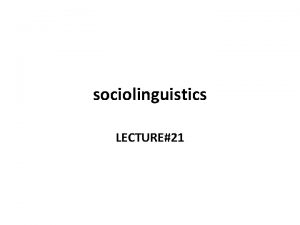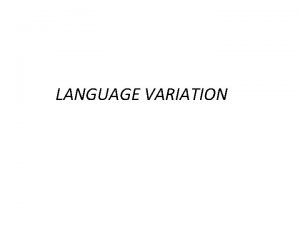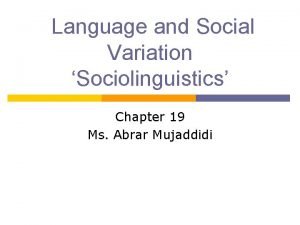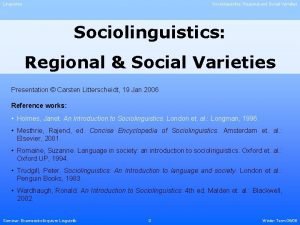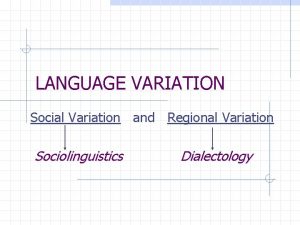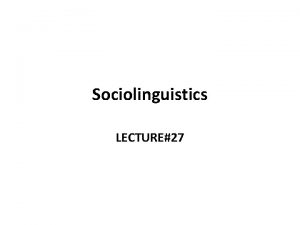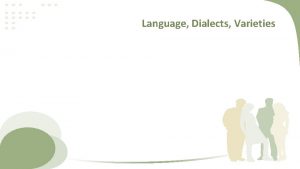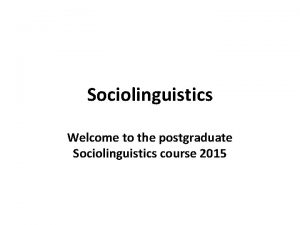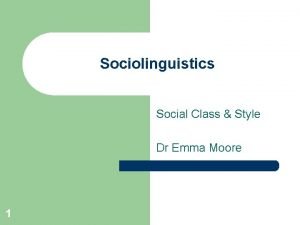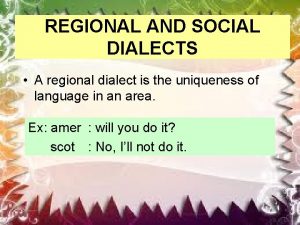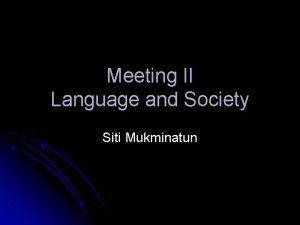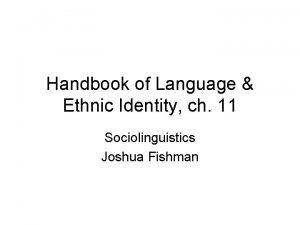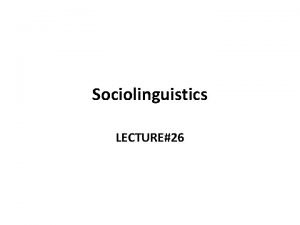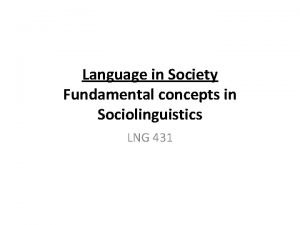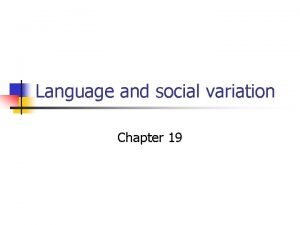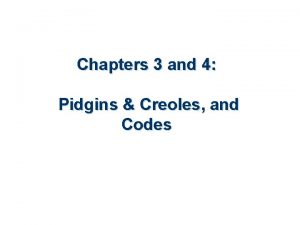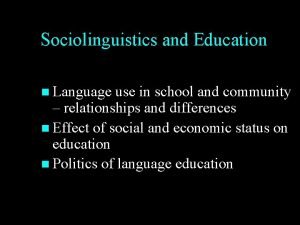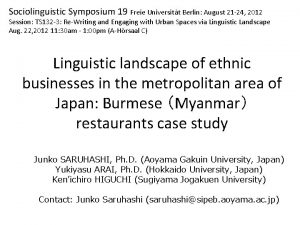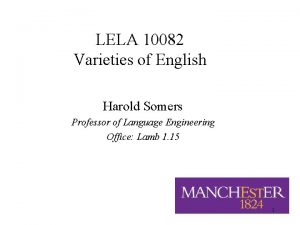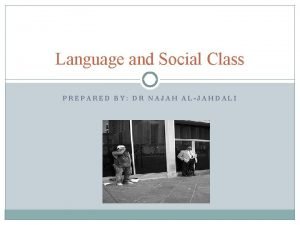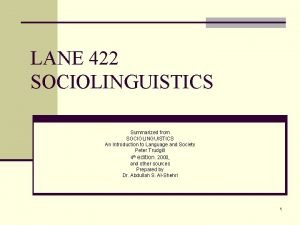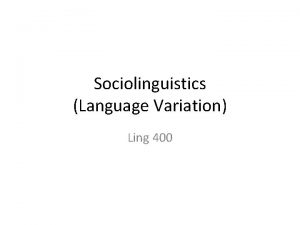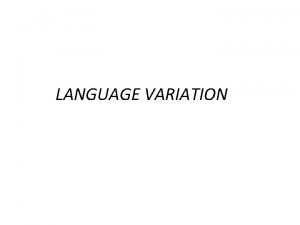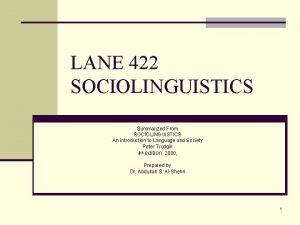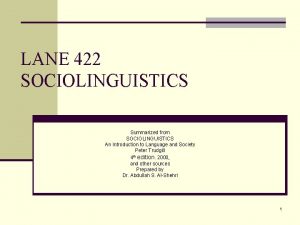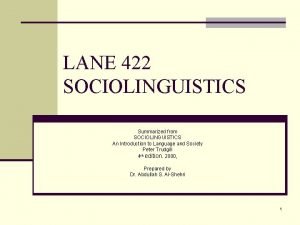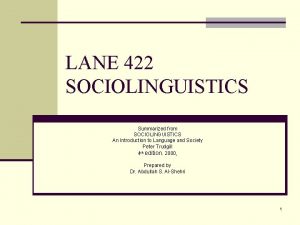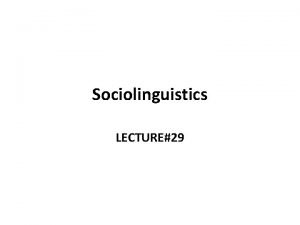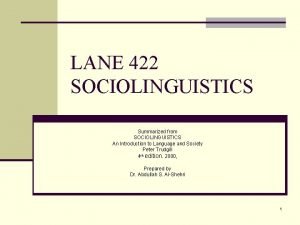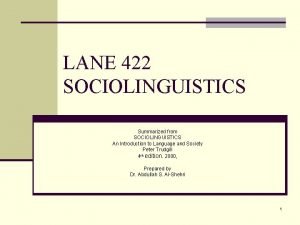The History of Sociolinguistics Seminar Language Variation Change










































- Slides: 42

The History of Sociolinguistics Seminar: Language Variation & Change Lecturer: Prof. R. Hickey Term: WS 07/08 Hildegard Schnel (LN, HS) Nadja Höckesfeld (TN, HS) Meike Strohn (TN, HS)

Introduction l From Dialectology to Sociolinguistics l William Labov’s studies - Martha‘s Vineyard - The Social Stratification of English in New York City

From Dialectology to Sociolinguistics HS: Language Variation and Change WS 2007/08 Hildegard Schnel Prof. Dr. Hickey

Content l l l l Definition: Dialectology Dialectological Terms Aims Methods Urban Dialectology Significance for Sociolinguistics References

Definition: Dialectology l l l study of language in relation to dialects from a regional angle begun by Georg Wenker in 1876 also called 'Dialect Geography' sub-discipline of linguistics ignoring social factors in language use and change

Dialectological Terms l Dialect / Dialect areas l Language l Variety l Accent

Dialectological Terms l Dialect not the standard form of a language – notion of low-status (working-class) – associated with the peasantry – lacking in prestige – differs grammatically, lexically and phonologically Example: "I done it last night“ [Cockney-English] "I did it last night“ [RP-English] –

Dialectological Terms l Dialect areas – – – London and the Home Counties East Anglia The South-West The Midlands (West Midlands; the East Midlands border on the Home Counties; East Anglia) The North l the north-west (Merseyside, Lancashire, Cumbria) l the north-east (Lincolnshire, Yorkshire) l the far north (Northumberland, north-east).

Dialectological Terms l Language non-technical term; less specific – “a language is a dialect with an army or a navy” – one dialect is not linguistically superior to any other – historical, political, geographical, sociological, cultural and linguistic reasons Example: German, Swedish, Danish –

Dialectological Terms l Variety – – – neutral term; specific any particular kind of language referring to language as a single entity Example: Yorkshire English Leeds English middle-class Leeds English

Dialectological Terms l Accent a speaker‘s way of pronouncing – refers to a variety – differs phonetically or phonologically Example: /bvt/ ; /bv? / –

Aims l l l l registering language use focusing on regional variants documenting individual place dialects linguistic geographic data producing linguistic maps analyzing language variation (phonology, semantics, syntax, lexis and morphology) ignoring social apects

Methods l l tape-recording non-mobile, elderly, uneducated, untravelled, rural males > biased choice of informants list of items questionnaire (written/oral) – – direct: one-word answers indirect: natural responses l l formal: questions in advance informal: free to form questions

Urban Dialectology l l l mid-20 th century dialects are both: regional + social trying to integrate social factors – l l l Linguistic Atlas of the United States and Canada (by Hans Kurath, 1930) focusing on urban dialects interested in phonology and grammar quasi-conversational speech choice of informants still biased considering the linguistic variable

Significance for Sociolinguistics l l arose out of Dialectology unbiased choice of informants random sampling required Dialectology provided analytic tools for dealing with language variation in actual speech – provided the linguistic variable Example: but > /bvt/ ; /bv? / –

References l l l www. uni-due. de/ELE Chambers, J. K. : Dialectology. Cambridge. 1980. Geobl, H. (ed): Dialectology. Quantitative Linguistics, Vol. 21. Brockmeyer. Bochum 1984.

The History of Sociolinguistics I HS: Language Variation and Change WS 2007/08 Nadja Höckesfeld Prof. Dr. Hickey

Sociolinguistics l l l l from the combining form socio- (referring to society) and linguistics scientific study of social language aspects focuses the relationship between language and social life emphasizes the communicative competence of speakers (communication abilities) stresses language variation (i. e. due to different backgrounds) language is not only used for communication and exchange of information but also to create identity there is not one sociolinguistic theory but different approaches exist depending on the linguistic interest

William Labov l l l American linguist professor at the University of Pennsylvania regarded as founder of sociolinguistics his goal: to identify how language varies in the community and draw conclusions from that for linguistic theory and everyday life (e. g. education) his methods for collecting data have become very influential in social dialectology

Case Study 1: W. Labov, Martha‘s Vineyard Setting: l Martha‘s Vineyard is an island about 3 miles off the East Coast of the USA l permanent population of about 6, 000 inhabitants l more than 40, 000 visitors a year l island is can be separated in different parts according to the people living there l a part of the original inhabitants was very opposed to the summer visitors

W. Labov, Martha‘s Vineyard About the study: l study took place from 1961 to 1963 l Labov studied the variations in diphthongs l the pronunciation of the diphthongs varies in the community and is called a linguistic variable l 69 tape – recorded interviews with speakers from different ages and ethnic groups from the island l Labov used a scoring system for his analysis l interviewees are divided into age groups

Linguistic theory Linguistic variable: l feature that has two or more identifiable linguistic forms l variants differ in form but that does not afflict their linguistic meaning Criteria for a linguistic variable: l frequent enough in ordinary conversation l structurally linked to other linguistic elements l exhibit a pattern of stratification due to social factors

W. Labov, Martha‘s Vineyard Results:

W. Labov, Martha‘s Vineyard Possible explanations: l a high degree of centralization shows belonging to the island resistance against the summer people l young people are still somewhat ambiguous and therefore do not have such a strong centralization l Older people follow an older way of speaking which does not involve that much centralization l People of the age group 31 – 45 probably have recently made experiences which lead to the centralization of the diphthongs

W. Labov, Martha‘s Vineyard Possible explanations: l Centralization indicates ‘Islander‘ status, loyalty, solidarity l Portuguese and Native people use centralization to show equality with original inhabitants

Bibliography Wardhaugh, Ronald. 1995. An Introduction To Sociolinguistics. Oxford UK & Cambridge USA: Blackwell. Mesthrie, Swann, Deumert, Leap. 2006. Introducing Sociolinguistics. Edinburgh: Edinburgh University Press. Coulmas, Florian (ed. ). 2000. The Handbook of Sociolinguistics. Oxford UK & Cambridge USA: Blackwell. Meyerhoff, Miriam. 2006. Introducing Sociolinguistics. Abingdon: Routledge. Holmes, Janet. 1992. An Introduction To Sociolinguistics. New York & Harlow Essex: Longman.

The History of Sociolinguistics II HS: Language Variation and Change WS 2007/08 Meike Strohn Prof. Dr. Hickey

The Social Stratification of English in New York City – William Labov 1. 2. 3. 4. Labov´s study of the varieties of English in New York City Techniques for gathering data Labov’s findings Conclusion

1. Labov´s Study of the Varieties of English in New York City l l l “The Social Stratification of English in New York City” (1966) social stratification: the condition of being arranged in social strata or classes within a group (www. thefreedictionary. com) “soziale Schichtung” Correlation between linguistic variation and social variation

S. Klein

Macy’s

Saks Fifth Avenue

1. Labov´s study of the varieties of English in New York City l l l the three department stores show different levels of PRESTIGE: Saks Fifth Avenue Macy’s S. Klein the work at either store is valued accordingly prediction: the personnel will be stratified according to these levels and will show respective linguistic features

1. Labov´s study of the varieties of English in New York City l l l the linguistic variable (r) has two variants: [r] and Ø example: a salesperson at Saks would presumably pronounce the (r) in far, a salesperson at S. Klein would use the r-less variety more often another possible linguistic variable: initial consonant (th) as in thing, three variants: 1) [t], 2) [t 2], 3) [2] ( not dealt with in this presentation)

1. Labov´s Study of the Varieties of English in New York City l Hypothesis: The linguistic variable (r) differentiates English in New York City - STATUS: correlation with social class - STYLE: if formality increases, r-usage increases as well - POSITION OF OCCURENCE: more likely at the end of words than before consonants - AGE: rather a feature of younger speakers

2. Techniques for gathering data l l l usage of rapid anonymous speech events to circumvent the “observer’s paradox” as informal and casual as possible in this case: - interviewer in the role of a customer - informants do not know that their language is being investigated „Where can I find lady‘s shoes? “ „Fourth floor. “ repetition emphatic speech

3. Labov’s findings - STATUS Percentage of r-use in three NYC department stores (based on Labov 1972) l The pronounciation of postvocalic [r] functions as a marker of the highest-ranking status group

3. Labov’s findings - STYLE R-pronunciation in NYC by social class & style of speech (based on: Labov 1966) l The more formal the situation, the more usage of postvocalic [r]. exception: hypercorrection of LMC

3. Labov’s findings - POSITION OF OCCURENCE l The r-pronunciation is more common at the end of a word than before a consonant

3. Labov’s findings - AGE l l l Saks and S. Klein: older people used less r-pronunciation than younger people Macy‘s: older people used more r-pronunciation than younger people conclusion: variable (r) is not generally a feature of young people members of middle social groups tend to change their pronunciation after adolescence; highest and lowest social groups rather do not

4. Conclusion l l speakers who are ranked in a scale of social stratification will be ranked in the same order by their different use of a linguistic variable socioeconomic differences cannot be ignored in linguistic studies

References l l Labov, William. 1966. The Social Stratification of English in New York City. Washington DC: Center for Applied Linguistics. Labov, William. 1976. Sprache im sozialen Kontext. Kronberg: Scriptor Verlag. Mesthrie, Rajend et al. 2006. Introducing Sociolinguistics. Edinburgh: Edinburgh University Press. Wardhaugh, Ronald. 1995. An Introduction To Sociolinguistics. Oxford UK & Cambridge USA: Blackwell.
 Importance of sociolinguistics
Importance of sociolinguistics Regional variation in language examples
Regional variation in language examples What is social variation in language
What is social variation in language Regional variation in sociolinguistics
Regional variation in sociolinguistics Language variation
Language variation Language variation and change examples
Language variation and change examples Direct variation
Direct variation Direct and inverse variation
Direct and inverse variation How to calculate sst in regression
How to calculate sst in regression Language dialect and varieties in sociolinguistics
Language dialect and varieties in sociolinguistics Differences between home language and standard language
Differences between home language and standard language Language
Language Levels of language knowledge
Levels of language knowledge Variationist sociolinguistics
Variationist sociolinguistics Sociolinguistics topics for presentation
Sociolinguistics topics for presentation What is overt prestige
What is overt prestige Sociolinguistics
Sociolinguistics What is social dialects
What is social dialects What is sociolinguistics
What is sociolinguistics Formality scale in sociolinguistics
Formality scale in sociolinguistics Ethnicity in sociolinguistics
Ethnicity in sociolinguistics Code switching in sociolinguistics
Code switching in sociolinguistics Register (sociolinguistics)
Register (sociolinguistics) Example of sociolinguistics
Example of sociolinguistics Speech community in sociolinguistics
Speech community in sociolinguistics Sociolinguistics slideshare
Sociolinguistics slideshare Pidgin and creole in sociolinguistics
Pidgin and creole in sociolinguistics Sociolinguistics and education
Sociolinguistics and education Malihka burmese restaurant
Malihka burmese restaurant Origin of sociolinguistics
Origin of sociolinguistics Linguistic prescriptivism
Linguistic prescriptivism Sociolinguistics topics
Sociolinguistics topics Frozen register
Frozen register Idiolect
Idiolect Variationist sociolinguistics
Variationist sociolinguistics Sociolinguistics
Sociolinguistics Language variation
Language variation Hát kết hợp bộ gõ cơ thể
Hát kết hợp bộ gõ cơ thể Bổ thể
Bổ thể Tỉ lệ cơ thể trẻ em
Tỉ lệ cơ thể trẻ em Voi kéo gỗ như thế nào
Voi kéo gỗ như thế nào Tư thế worms-breton
Tư thế worms-breton
